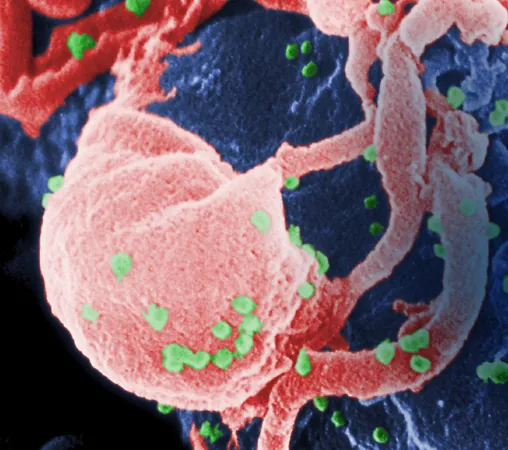
The Unseen Threat: Why Low-Level Viremia in HIV Patients Demands Urgent Attention
2024-11-07
Author: Nur
As the battle against HIV continues, a pressing issue has emerged: low-level viremia (LLV) in people living with HIV (PLWH). This phenomenon, where HIV RNA is detectable at low levels despite effective antiretroviral therapy (ART), poses a significant risk that is often overlooked.
Understanding HIV and LLV
HIV, a single-stranded RNA virus, can be transmitted through various means, including sexual contact, mother-to-child transmission, needle sharing, and contaminated blood transfusions. According to the World Health Organization (WHO), approximately 39.9 million individuals were living with HIV globally by the end of 2023. Since 2010, the incidence of HIV and related mortalities has seen remarkable declines of 39% and 51%, respectively, thanks largely to advances in ART. These medications can suppress HIV RNA levels to undetectable amounts, allowing PLWH to lead healthier lives.
Prevalence and Classification of LLV
However, even with effective treatment, a significant number of patients experience LLV, characterized by low but detectable viral loads. Studies indicate that LLV affects approximately 18% to 34% of individuals undergoing ART, with specific levels categorized as very low-level viremia (VLLV), low-level viremia (LLV), and high low-level viremia (HLLV).
Current Guidelines and Their Limitations
Despite its prevalence, current guidelines from authorities such as the US Department of Health and Human Services (DHHS), the European AIDS Clinical Society (EACS), and WHO provide inadequate direction for managing LLV. The definitions of clinical success vary significantly among these organizations, complicating the management of LLV cases. For instance, while the WHO considers less than 1000 copies/mL as clinically successful, the DHHS and EACS suggest lower thresholds to minimize complications and transmission risks.
Health Risks Associated with LLV
Alarmingly, LLV is not benign. Research has linked persistent LLV (PLLV) and HLLV (PHLLV) to an increased risk of serious non-AIDS-related health issues, including various cancers, cardiovascular diseases, and liver complications. Chronic immunological activation and inflammation have also been observed in patients with PVLLV, emphasizing a potential pathway to deterioration in overall health. This situation has raised concerns regarding long-term virologic failure and ART resistance associated with these persistent low-level viral loads.
Need for Further Research
However, the exact risk of transmission for PLWH with PLLV remains under-explored; previous studies have primarily focused on patients with higher HIV RNA levels. Therefore, further investigation is necessary to elucidate the implications of LLV on transmission rates.
Urgent Call for Updated Clinical Recommendations
In light of the limited available guidance and the substantial prevalence of LLV among PLWH, there is an urgent need for updated clinical recommendations. Some studies suggest that optimizing ART regimens through drug-resistance testing (DRT) could enhance virologic outcomes for patients with PLLV. Specifically, switching to more potent therapeutic options has resulted in successful outcomes for individuals who were previously on less effective ART.
Challenges in Management
Nevertheless, challenges persist. The availability and cost of DRT, especially in low- and middle-income countries, hinder optimal management of LLV. Furthermore, standard DRT methods typically require viral loads to be above 1000 copies/mL to be effective, leaving a significant gap in our ability to monitor resistance in patients with LLV.
Conclusion
As the field moves forward, it is essential to recognize the serious implications of untreated or inadequately managed LLV. A revised approach to guidelines is critical to address this issue, ensuring that PLWH can maintain their health and avoid potential long-term complications linked to LLV and its associated risks. The call for greater research and improved clinical pathways for management grows increasingly urgent as we strive for a future where every person living with HIV can achieve the best possible health outcomes.
Stay informed, as the fight against HIV evolves and the narratives surrounding PLWH continue to unfold!




 Brasil (PT)
Brasil (PT)
 Canada (EN)
Canada (EN)
 Chile (ES)
Chile (ES)
 Česko (CS)
Česko (CS)
 대한민국 (KO)
대한민국 (KO)
 España (ES)
España (ES)
 France (FR)
France (FR)
 Hong Kong (EN)
Hong Kong (EN)
 Italia (IT)
Italia (IT)
 日本 (JA)
日本 (JA)
 Magyarország (HU)
Magyarország (HU)
 Norge (NO)
Norge (NO)
 Polska (PL)
Polska (PL)
 Schweiz (DE)
Schweiz (DE)
 Singapore (EN)
Singapore (EN)
 Sverige (SV)
Sverige (SV)
 Suomi (FI)
Suomi (FI)
 Türkiye (TR)
Türkiye (TR)
 الإمارات العربية المتحدة (AR)
الإمارات العربية المتحدة (AR)